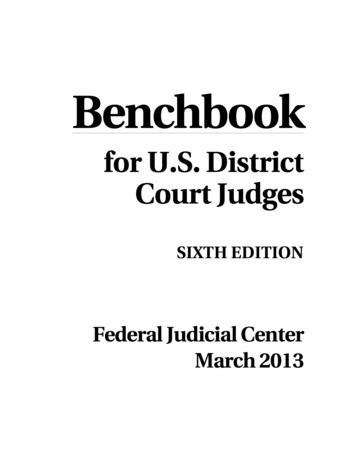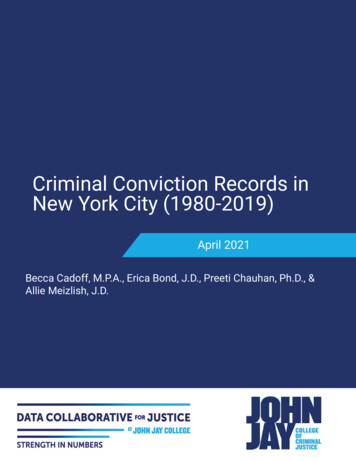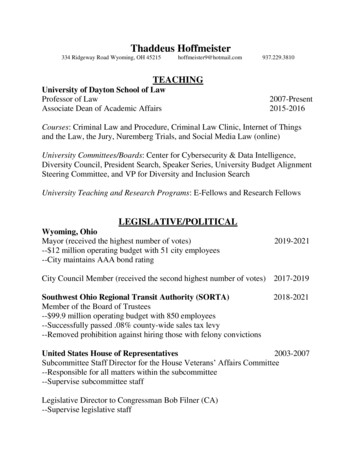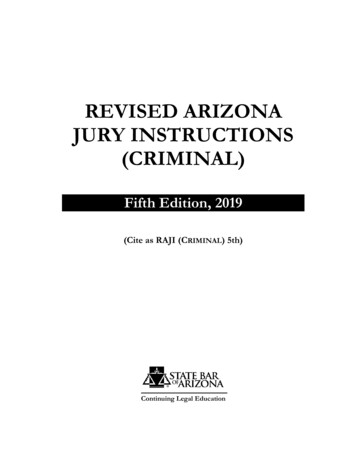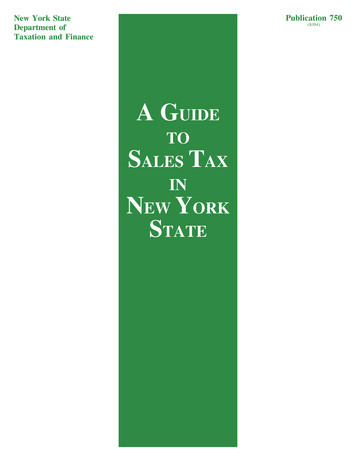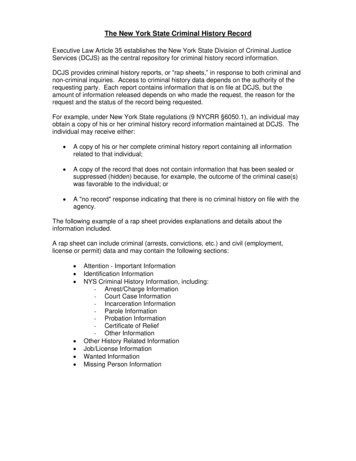
Transcription
The New York State Criminal History RecordExecutive Law Article 35 establishes the New York State Division of Criminal JusticeServices (DCJS) as the central repository for criminal history record information.DCJS provides criminal history reports, or “rap sheets,” in response to both criminal andnon-criminal inquiries. Access to criminal history data depends on the authority of therequesting party. Each report contains information that is on file at DCJS, but theamount of information released depends on who made the request, the reason for therequest and the status of the record being requested.For example, under New York State regulations (9 NYCRR §6050.1), an individual mayobtain a copy of his or her criminal history record information maintained at DCJS. Theindividual may receive either: A copy of his or her complete criminal history report containing all informationrelated to that individual; A copy of the record that does not contain information that has been sealed orsuppressed (hidden) because, for example, the outcome of the criminal case(s)was favorable to the individual; or A "no record" response indicating that there is no criminal history on file with theagency.The following example of a rap sheet provides explanations and details about theinformation included.A rap sheet can include criminal (arrests, convictions, etc.) and civil (employment,license or permit) data and may contain the following sections: Attention - Important InformationIdentification InformationNYS Criminal History Information, including:- Arrest/Charge Information- Court Case Information- Incarceration Information- Parole Information- Probation Information- Certificate of Relief- Other InformationOther History Related InformationJob/License InformationWanted InformationMissing Person Information
Attention - Important InformationThis section includes banners that, when present, alert the recipient to certaininformation that is on the rap sheet and to the restrictions on the dissemination of suchinformation. The following is an example of some available banners:2
Identification InformationThis section provides the name and other personal information of the subject of the rapsheet.Name may include multiple names and aliases.Date of Birth could include multiple dates.Place of Birth is the place where the individual was born.Address may list multiple addresses.3
Sex, Race, Ethnicity and Skin Tone indicate information most often reported.However, if multiple sexes are reported, all reported sexes will be shown; ifmultiple races, ethnicities and skin tones are equally reported, more than oneentry will appear.Eye Color, Hair Color, Height and Weight indicate information most recentlyreported.SSN (Social Security number) may list more than one number.NYSID # (New York State Identification Number) is a unique number assigned byDCJS to an individual with criminal and/or civil New York State history. Anindividual may have more than one NYSID number if all previous histories aresealed.FBI # (Federal Bureau of Investigation Number) is the primary identification andfile number assigned by the FBI.Probation Client ID # is an identification number attached, if applicable, to anindividual’s probation supervision history.NCIC Classification # is the National Crime Information Center fingerprintclassification number.III Status (Interstate Identification Index status) indicates whether or not there isinformation available in states other than New York.US Citizen indicates whether or not the subject is a US citizen.Note: Any information associated only with sealed records will not display unlessthe release of the sealed data is permitted by law. However, an individual iseligible to receive a copy of his or her own record that contains sealedinformation.4
New York State Criminal History InformationThis section displays criminal events or “cycles” maintained in DCJS records. Eachcycle refers to when a person was fingerprinted.Arrest/Charge InformationArrest charges are reported by the arresting agency and usually are supported by anarrest fingerprint transmission. Charges that are arraigned and disposed by the court arereported under “Court Case Information.”“No Arrest Reported” will appear in place of the arrest information when the arrestingagency did not submit the arrest.If special circumstances apply to this arrest, there will be additional information belowthe cycle number, and before the arrest date, which may include the following: Cycle may not be supported by fingerprints - This arrest does nothave fingerprints on file to support the data. Violent Felony Offense - This cycle contains a charge which is classifiedas a violent felony, as defined in New York State Penal Law Article 70.02.The charge may be an arrest, arraignment, and disposition or institutionadmission charge.5
Domestic Incident Report Filed - There was a Domestic Incident Reportfiled at the time of the arrest. This is not an Order of Protection. Youthful Offender - This cycle contains a youthful offender (YO)adjudication finding by the court. Juvenile Offender - The charges at the time of arrest are consideredjuvenile offender (JO) charges. Juvenile Delinquent - The charges at the time of arrest are consideredjuvenile delinquent (JD) charges.Court Case InformationCourt information appears directly below the arrest/charge information for the relatedarrest.Court is the name of the court where the case was heard.Case Number is used for identifying a docket number in local courts and anindictment number or superior court information number in superior courts.The disposition is the action taken by the court and the date of that action. Rap sheetrecipients need to be aware that disposition data is always being updated. Courts reportdispositions electronically to DCJS. If a disposition has not been reported to DCJS, “NoDisposition Reported” will appear instead of the court information.The charges listed above are arraignment and disposition charges. They are differentthan arrest charges because they refer to charges that are prosecuted. Charges thatare dismissed as a result of a plea agreement may be listed here following, “In FullSatisfaction of,” and charges that are reduced from another charge may be listed herefollowing, “Reduced from.”The sentence and date sentenced will be displayed at the end.If an arrest and disposition resulted in an outcome favorable to the defendant, the rapsheet may look as follows:6
Favorable outcomes are sealed pursuant to New York State Criminal Procedure Law(CPL) §§160.50, and 160.55, and conditionally sealed pursuant to CPL 160.58. This isdisplayed at the end of the court case that is sealed.In all cases, except for marijuana charges adjourned in contemplation of dismissalpursuant to CPL 170.56, the fingerprint card supporting the arrest is destroyed when anaction is "Sealed in Termination of a Criminal Action in Favor of the Accused CPL160.50". If there are multiple court cases for a cycle, all cases must result in a seal inorder for the entire cycle to be sealed and the fingerprints destroyed.These sealed arrests and dispositions would not be included in the rap sheets, unlessrelease of the information is authorized by law or an individual chooses to obtain a copyof his or her own criminal history record with those sealed arrests and dispositionsincluded.7
Incarceration InformationLocal jails and the New York State Department of Corrections and CommunitySupervision (DOCCS), which operates the state’s prisons, report incarcerationadmissions to DCJS when a sentenced person is first admitted to a facility. DOCCSalso reports to DCJS when the inmate is released from the facility, and as appropriate, ifthe inmate is returned to the facility upon a parole violation.Admission Date is the date that the individual is admitted to local jail or stateprison.Admission Reason is the reason for admission.Agency is the entity reporting the initial admission information. Note: DOCCSdoes not report when an inmate is transferred from one prison to another.State Inmate ID No. is the number assigned by DOCCS or the local facility. It isoften referred to as the "DIN" Number.Sentence to refers to the period of incarceration as decided by the court at thetime of sentencing.Max Expiration Date is the last date on which the inmate will complete the fullterm of his or her sentence.Conditional Release Date is the earliest date on which an individual must bereleased from incarceration.Release Date is the date when the individual is released from incarceration.Release Reason is the reason for release from incarceration.8
Parole InformationDOCCS reports data electronically to DCJS at various stages of the supervisionprocess, including when an individual is released from prison and placed on parole;when the individual completes his or her parole term and is discharged; or when paroleis revoked for some reason (for example, commission of another offense).Note: An individual also may be sentenced directly to parole supervision by the courtwithout first being incarcerated. The area of assignment will be listed as “Willard.” If adisposition is present in the event, the sentence area should read, "Parole SupervisionSentence.”Received by Parole on is the date the individual was released from prison andplaced on parole.Release Type is the reason for release to parole.Max Expiration Date is the last date on which the individual will complete his/herparole term.Supervision Office is the area to which the individual on parole is assigned.Parole ID Number is the same number as the Inmate ID Number.Discharge from Parole on is the date the individual was discharged fromparole.Discharge Type is the reason the individual is no longer under parolesupervision.9
Probation InformationThis information is reported electronically by probation departments as shown below:Placed on Probation is the date an individual is placed on probation.Maximum Expiration Date is the last date on which the individual will completehis or her probation term.Supervision Agency is the county probation department to which the individualreports.Jurisdiction Agency is the probation department having legal responsibility forthe probationer. In some instances, an individual may be supervised by anothercounty because of his or her residence, or other reasons, but jurisdiction wasretained by the judge in the county where the individual was sentenced.Probation Officer ID identifies the officer to whom the individual reports.Probation Registration Number is the number used to identify a supervisioncase. If an individual has multiple probation sentences, there will be a uniquenumber for each one.Probation Case Number is the number identifying the individual who transferredto New York as an out-of-state transfer case.Probation Discharge Date is the date when the individual is no longer underprobation supervision.Discharge Type is the reason individual is no longer under probationsupervision.10
Certificate of Relief (from Civil Disabilities)A Certificate of Relief from Civil Disabilities may be issued by the court or by DOCCS toan individual who has been convicted of any number of lesser offenses and up to onefelony (Correction Law §§ 701-703).The purpose of the Certificate of Relief is to relieve the individual of any forfeiture ordisability, such as removing a bar to his or her employment that was automaticallyimposed upon his or her conviction for a single arrest, except for the right of a person toretain or to be eligible for public office.The Certificate of Relief does not restrict any judicial, administrative, licensing or otherbody, board or authority from lawfully relying upon the conviction detailed in thecertificate as the basis for exercising its discretionary power to suspend, revoke, refuseto issue or refuse to renew any licenses, permit, or other authority or privilege.Granting a Certificate of Relief does not remove the underlying conviction from theoffender’s criminal record and does not result in the case being sealed.The certificate can be modified or revoked at any time between the date issued and thePermanency Date. After the Permanency Date, the certificate can no longer be alteredor revoked.Other InformationThis section contains New York State arrest, disposition, incarceration and supervisioninformation that was recorded prior to Feb. 1, 1972. These events do not have as muchdetailed information as the events appearing in the “Criminal History Information”section of the rap sheet.11
Other History-Related InformationThis refers to information about the individual who is the subject of the rap sheet thatdoes not pertain to a specific cycle. Data under this heading may pertain to, but is notlimited to, Certificates of Good Conduct.A Certificate of Good Conduct may be issued by DOCCS to relieve an individual of anydisability or bar to employment (Correction Law §§703-a, 703-b). It may be limited toone or more listed disabilities or bars, or may relieve the individual of all disabilities andbars. The individual must have demonstrated a minimum period of good conduct in thecommunity of one year for a misdemeanor conviction, three years for a Class C, D or Efelony conviction, and five years for a Class A or B felony conviction.Granting of a Certificate of Good Conduct does not remove the underlying conviction. Itdoes not prevent a prospective employer or licensing agency from lawfully deciding torefuse employment, or to refuse a license. However, the issuance of a Certificatecreates a presumption of rehabilitation in connection to the offense or offenses it coversfor license or employment purposes.The Issue Date is the date on which the certificate was issued. The Certificate can bemodified or revoked at any time between the date of issuance and the PermanencyDate. After the Permanency Date, the certificate can no longer be altered or revoked.Job/License InformationThis section of the rap sheet contains information about the individual pertainingto job or license applications that required him or her to undergo a fingerprintbased criminal history background check. This information is not related tocriminal activity.The appearance of job or license information on the rap sheet does not meanthat the individual was hired or the license was granted.However, in the case of a pistol license (permit), the rap sheet will include thedate that the pistol permit was granted if the local licensing official provided thatinformation to DCJS.12
Wanted InformationIf criminal history is located, wanted records containing the New York State IdentificationNumber (NYSID#) will be returned. If no information is returned, the rap sheet willcontain the following message:Missing Person InformationIf no information is returned, the rap sheet will contain the following message:13
6 Domestic Incident Report Filed - There was a Domestic Incident Report filed at the time of the arrest. This is not an Order of Protection. Youthful Offender - This cycle contains a youthful offender (YO) adjudication finding by the court. Juvenile Offender - The charges at the time of arrest are considered juvenile offender (JO) charges.





